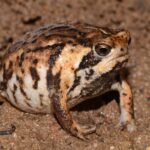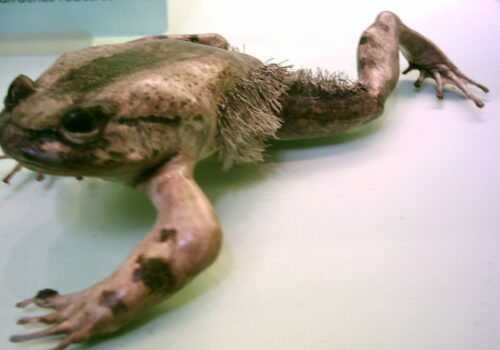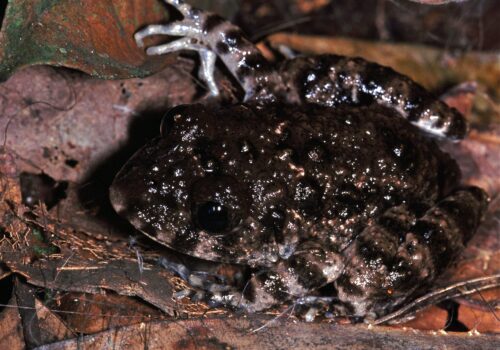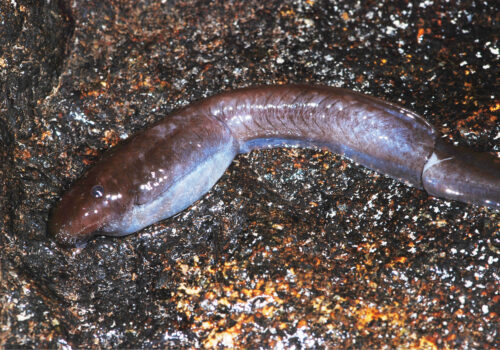Leptopelis oryi: Discovering the Enigmatic Forest Guardian of West Africa#
Hidden amidst the dense foliage and shimmering pools of West Africa’s verdant forests, a small, strangely captivating frog lends its voice to the nighttime chorus, subtly influencing the rhythm of the jungle. Known scientifically as Leptopelis oryi, this intriguing amphibian remains relatively unknown to the wider world but is beloved by naturalists who brave humid nights to record its haunting, melodic calls. Echoing through the African forest, the calls of Leptopelis oryi are not merely background sounds—they are integral to the fabric of its ecosystem, its melodies cryptic whispers of wilderness secrets.
This vibrant species, though not as famous or attention-grabbing as the brilliantly colored poison dart frogs of the New World tropics, embodies the subtlety and quiet beauty characteristic of West Africa’s understudied rainforest gems. Its fascinating adaptations, intriguing behavior, and the uncertain status of its conservation highlight the need to understand—and protect—Earth’s lesser-known amphibian wonders.
Taxonomy and Classification#
Leptopelis oryi belongs to the family Arthroleptidae, an interesting group of frogs predominantly found across sub-Saharan Africa. Members of Leptopelis, commonly called forest tree frogs or bush frogs, are generally arboreal, meaning they spend much of their life perched amongst leafy branches rather than lurking solely ground-level pools. Within this diverse genus, L. oryi is identified through a distinct set of morphological and vocal characteristics outlined by herpetologists.
The genus Leptopelis was first described by Günther in 1859, and since then, has been widely studied as an evolutionary success story. These species showcase extraordinary adaptability, thriving in a variety of habitats from montane forests to lowland savanna edges. Yet, despite their adaptability, many Leptopelis species, including L. oryi, remain significantly under-documented. Each species differentiation, such as that of L. oryi, offers scientists critical insight into biodiversity and evolutionary processes in dynamic rainforest ecosystems.
Natural Habitat#
Leptopelis oryi’s geographic distribution primarily focuses in a patchwork of humid forest habitats across Côte d’Ivoire, Ghana, Guinea, Sierra Leone, and Liberia. It favors primary rainforests, secondary forest regenerations near wetlands, and sometimes even plantations or degraded forest remnants—wherever sufficient humidity, vegetation cover, and partial canopy accessibility exists.
Within these lush habitats, a symphony of sounds dominates nights flanked by dense foliage. From gently flowing streams to rainwater pools, the frog’s intimate connection with water sources is essential. Naturally adapted for arboreal life, these frogs employ small tree hollows, broad leaves, and dense thickets as shelter. Life high above forest floors not only offers protection from certain predators but also assists them in projecting their calls effectively into the surrounding drizzle-tinged night.
The Importance of Microhabitats#
Interestingly, Leptopelis oryi shows observable sensitivity toward structural variations within its habitat. It flourishes particularly well in microhabitats characterized by moss-laden branches, large bromeliads cradling rainwater, decaying logs laden with moisture, and shaded streamsides. These microhabitats allow the frogs to evade dehydration, predators, and intense solar exposure while also providing a stable site for breeding and feeding activities.
Physical Characteristics#
An undeniable charm accompanies the adult Leptopelis oryi; their bodies, generally measuring between 35 to 45 millimeters in length, are modestly proportioned, yet reveal fascinating adaptative details upon closer examination. Their coloration typically oscillates between shades of olive-green, brown, or grey—sometimes a camouflaged blend—accented occasionally by darker markings. Such subtle hues and cryptic coloration perfectly mirror their habitat’s leafy textures, providing an ideal measure of concealment from both prey and predator.
Their large, expressive eyes are often a golden-yellow or bronze hue, lined with strikingly visible horizontal pupils adapted superbly for nocturnal activity. Their limbs, slender and muscular, end in specialized toe pads—biological marvels allowing the frogs exquisite agility within branches and wet foliage. The skin, smooth and moist to the touch, serves crucial respiratory and thermoregulatory functions. Notably, this intricately adaptive skin provides a moist membrane essential for efficient oxygen transfer necessary during arboreal rest periods and breeding activity.
Behavior and Life Cycle#
Nocturnal Predators and Climbers#
Most active under the cool veil of night, Leptopelis oryi engages its ecosystem with subtle efficiency. Equipped for a predatory lifestyle, these frogs patiently hunt various prey—including insects, spiders, and small arthropods—which inhabit vegetation and forest floor layers. Their hunting strategy involves stealthy movements, visual precision honed by extraordinary eyesight, and adept tongues that snatch prey swiftly from the surrounding vegetation or air.
A Symphony of Courtship#
Perhaps the most intriguing behavior is the male’s distinctive call—an enchanting, rhythmic pulse carrying melodically into the forest night. The calling typically peaks after rainfall, when the forest humidity permeates every crevice and leaf. Males strategically position themselves among vegetation above water bodies to broadcast their serenades clearly, attracting receptive females for mating.
The Miracle of Reproduction and Development#
Female Leptopelis oryi deposit their gelatinous egg clusters over subdued freshwater sources—small pools, streams, or rain-filled leaves—and the developing progeny will eventually drop into these pools as tadpoles. The tadpoles embark upon a critical aquatic phase, filtering microorganisms and algal particles for sustenance. As remarkable survivors, these tadpoles remain alert and agile, capable of swift darts away from predators, before gradually metamorphosing into fully arboreal froglets whose lives shift quickly upward into trees and vines.
Ecological Role#
Within the intricate network of rainforest life, every species plays a valuable part. Leptopelis oryi contributes significantly as both predator and prey within its niche. Small arthropod populations remain balanced due partly to the feeding habits of these frogs, limiting insect-borne diseases and facilitating the nutrient cycling process. Conversely, their presence as prey sustains avian predators, small carnivorous mammals, reptiles, and even other amphibians—forming links between food webs connecting ground-level and arboreal ecosystems.
Additionally, as amphibians generally exhibit sensitivity toward environmental contaminants and climate shifts, Leptopelis oryi could potentially act as a biological indicator, alerting conservationists to ecological degradation or environmental shifts before irreversible damage occurs.
Threats and Conservation Status#
Unfortunately, like many understated treasures of Earth’s wildlife, this enigmatic frog faces pressures from habitat fragmentation, deforestation, pollution, and climate change. Logging, agricultural expansion, and mining operations pose immediate threats to its rainforest home, trading lush, protected enclaves for increasingly inhospitable terrain.
While the IUCN currently lists Leptopelis oryi as Least Concern, the categorization largely stems from insufficient comprehensive population data and should not lessen urgency for protection. Biologists, conservationists, and communities need strategic collaboration to ensure this species’ lasting presence, exploring habitat restoration programs, sustainable land-use policies, and education outreach to boost local awareness and appreciation.
Cultural and Scientific Significance#
Though not widely entering the global cultural narrative, Leptopelis oryi finds mention among indigenous communities as subtle symbols of forest health and water abundance. Scientifically, their relative obscurity underscores the necessity of further research and biodiversity documentation initiatives, essential steps in conserving ecosystems and species diversity.
Conclusion#
Though small in size and discreet in behavior, Leptopelis oryi embodies the vitality and vulnerability of rainforest ecosystems in West Africa. This delicate yet pivotal species urges us toward greater ecological consciousness, reminding us that Earth’s biomass tapestry profoundly intertwines the large and small, prominent and subtle. Advocating for its protection, educating ourselves and others, engaging in conservation efforts—we ensure the survival of hidden wonders like Leptopelis oryi, safeguarding nature’s enigmatic legacies for generations to come.










